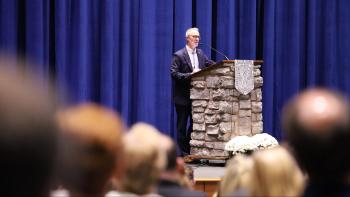This year’s celebration of Catholic schools comes at the right time. Whether one looks to conflict in the world or the negative tenor of discourse on social media, there are plenty of reasons to be discouraged. One reason for optimism is our system of 34 Catholic schools educating just under 9,000 students.
Our schools are embracing what we refer to as Catholic Education 3.0, a revitalization of faith formation and a renewal of educational excellence. It’s worth noting that the first two waves of Catholic education helped shape generations of Catholics for hundreds of years. The first wave (1.0) occurred in the late 1800s when Catholic Bishops met in Baltimore for what was called a “plenary council.” It was decided that parishes should have schools for Catholic students to study within a faith-filled environment.
At that time, there was fierce anti-Catholic sentiment among a predominantly Protestant America. Catholic leaders knew that the transmission of faith and culture would be lost within such a hostile environment. Schools were seen as the Church’s best bet for countering the culture and ensuring a strong future. As more Catholics came to the United States, more schools were built.
This period was the foundation of Catholic education, leading to the second wave (2.0). Over time, Catholic schools figured out how to achieve excellence on a number of fronts. Graduates became chief justices, astronauts, and pro athletes. Catholics were no longer looked down upon by popular culture.
Schools added sports, which added turf fields and field houses. Schools added AP courses and honors tracks, which enhanced college placement. Schools added STEM (Science-Technology-Engineering-Math) into their curriculum.
All the while, the Catholic heartbeat of schools went into decline. Faculties that were once dominated by religious sisters became primarily lay. Fewer priests led schools. Fewer practicing Catholic families sent their kids to schools. Schools began to close.
Painfully (but also fortunately), this period led schools to reconsider its core mission: to transmit Catholic faith to its students so that they could then transform the world. A new wave (3.0) was born as classical, home-school, and faith-forward schools emerged. Some schools were started anew while others recommitted to putting Christ back at the center of their educational goals.
What does it mean to be faith-forward in our schools? In Allentown, we see Catholicism as interwoven into every aspect of education. From curriculum to the arts, from athletics to hiring, from facilities to fundraising – our faith is central to all that we are. We see Catholic schools not merely as alternatives to public schools but as an entirely different way of seeing the world. Our schools can and will become, once again, the Church’s best means of raising up young people in the faith.
Our high school theatre productions remind attendees of the Church’s commitment to the arts. Evangelization teams are springing up in both elementary and secondary schools. Our special learning centers invite students to find Christ through the Sacraments. Our faculties are being formed in their faith through group catechesis. In short, we are leaning into Catholic Education 3.0, and it’s exciting!
There is tangible reason for optimism here in the Diocese of Allentown as seen within our 34 schools. I am grateful for the trust that families place in our excellent faculties and staffs and look forward to the next year of faith-forward education.
By Michael St. Pierre, Ed.D., Superintendent of Catholic Education, Diocese of Allentown.
Photo by Norm Steinruck.








